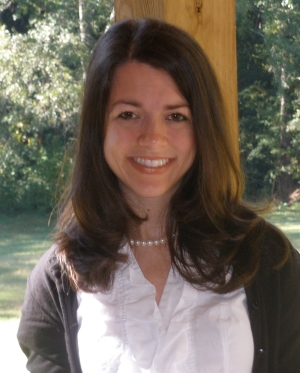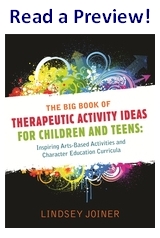 Lindsey Joiner is a Positive Behavior Specialist with Meridian Public School District in Mississippi, USA. She is a Licensed Professional Counselor, National Certified Counselor, and Approved Clinical Supervisor. She is the author of the new activities book, The Big Book of Therapeutic Activity Ideas for Children and Teens: Inspiring Arts-Based Activities and Character Education Curricula.
Lindsey Joiner is a Positive Behavior Specialist with Meridian Public School District in Mississippi, USA. She is a Licensed Professional Counselor, National Certified Counselor, and Approved Clinical Supervisor. She is the author of the new activities book, The Big Book of Therapeutic Activity Ideas for Children and Teens: Inspiring Arts-Based Activities and Character Education Curricula.
Here, Lindsey discusses how creative activities can work wonders in engaging and motivating children and teens, and improving their enjoyment and attendance in therapeutic sessions.
Tell us about yourself, and how your new book came about.
I currently work in a school setting as behavior specialist. I work with students from preschool through 12th grade who have a variety of behavior problems including defiance, ADHD, depression, autism, abuse/neglect issues, and anxiety. Before coming to the school setting, I worked in a community mental health center, leading and later supervising day treatment group for children and teens of all ages. I also have experience working with individuals with substance abuse and addictions.
 When I was fresh out of school and first started working in community mental health, I had no idea what to do for the 2 hour and 5 hour groups that I led each day. The participants were quickly bored with the social skills worksheets or discussions on conflict resolution that I would attempt to use to fill the time. I began to notice how many of the participants would draw and complete art projects during free time. It occurred to me to try to incorporate those interests into our group time. As I began to use more and more creative activities in a therapeutic way, a big change happened in those groups. The participants were more excited, more motivated, and more willing to participate. Attendance and individual progress toward therapeutic goals improved significantly. With this success, I began to incorporate more and more creativity into these therapeutic sessions.
When I was fresh out of school and first started working in community mental health, I had no idea what to do for the 2 hour and 5 hour groups that I led each day. The participants were quickly bored with the social skills worksheets or discussions on conflict resolution that I would attempt to use to fill the time. I began to notice how many of the participants would draw and complete art projects during free time. It occurred to me to try to incorporate those interests into our group time. As I began to use more and more creative activities in a therapeutic way, a big change happened in those groups. The participants were more excited, more motivated, and more willing to participate. Attendance and individual progress toward therapeutic goals improved significantly. With this success, I began to incorporate more and more creativity into these therapeutic sessions.
The book evolved as I began to write down some of the activities that I successfully used with children and teens to share with others in presentations and supervision sessions.
In the book you include a very eclectic mix of arts-based activities including film, art, music and books. Why do you think arts-based activities are particularly effective for working therapeutically with children?
In my experience, most children do not respond well to “talk therapy.” They often have difficulty expressing themselves, their thoughts, and their feelings with just words. Arts-based activities provide them with the tools they need to communicate effectively. Children and teens tend to be naturally creative. By providing activities that tap into this creativity, children will become more comfortable with the therapeutic process and are more likely to be actively involved in the counseling process. I have found that it helps many children and teens to have the tangible art creation to use to illustrate the therapeutic concept in the counseling session. The art creation can also be used as a symbol and reminder of the child’s goals and the progress he made through the counseling process long after the counseling sessions have ended. Finally, in my practice, many children and teens who struggle academically in school are often talented and interested in the arts and other creative forms of expression. By utilizing creative activities and lessons, the counselor can provide opportunities for the child to be successful and build a positive self concept through the therapeutic process.
As a school counsellor, what kind of problems do you most commonly encounter in the children you work with?
I think the most common problem I encounter with the students I work with is defiance – not doing what is asked of them in the classroom setting. However, after working with the student and finding out more about him, there are almost always other issues that are impacting the student and influencing his behavior. He may be behind his peers academically and feel embarrassed in the classroom. He may have to stay up late taking care of younger siblings and feel tired during the day at school. She may not have a consistent place to live or not know where her next meal is coming from each day. Arts-based activities provide students with a safe outlet to discuss these issues and allow the student and counselor to identify ways to handle them. Other problems that I frequently encounter include attention and hyperactivity issues, autism, and depression.
Have you found that the issues affecting them have changed through the course of your career?
I have observed an increase in children with mental health concerns over my years of practice, particularly with emotional problems and autism. This increase could be attributed to many different individual and societal issues, but it underscores the importance of providing quality mental health services for children and teens. Arts-based therapeutic activities can help facilitate every phase of the counseling process. These activities will help the counselor build rapport with the child, provide a framework to use when exploring and discussing thoughts, feelings, and issues, and can be utilized as part of a transition plan when the child has accomplished her therapeutic goals. Arts-based activities such as journaling, drawing, and writing songs can be taught and practiced within the counseling relationship and then continued outside of therapy as a healthy outlet for expressing feelings, thoughts, and frustrations and coping with problems throughout the child’s life.
The book features guidance and sample curricula for setting up therapeutic/character education ‘day camps’. Tell us about your experiences of day camps, and what they have to offer children.
I am so thankful to have had the opportunity to coordinate and lead several series of therapeutic day camps. Participating in these camps has had a profound impact on me as well as the children, teens, and other staff members that have been a part of these meaningful events. The therapeutic day camps are filled with enjoyable activities and allow the children to learn and practice therapeutic skills in a fun atmosphere without feeling like they are in “therapy.” The camps offer the time and space to extensively teach concepts like social skills, anger management, and goal setting through participation in a series of activities that break the concepts down and present the topics with symbolic projects and hands-on lessons. Each child leaves the camp with tangible reminders of what they learned that can help them to retain the information long after the camps are completed. The activities from the camps can be adapted to many different group settings and can be conducted over a series of days or weeks depending on the needs and logistics of the group.
How do you channel your own creativity and come up with the ideas?
As a child and adolescent, I really did not consider myself to be creative. I put a lot of pressure on myself to do everything “perfectly.” In order to be creative, a person really has to let go of the need to be “perfect” or “right” and be willing to try new things and look at things in a new way. As I have grown both personally and professionally, I tend to find inspiration and creativity in almost everything. Books, Internet blogs, magazines, music, cooking, and nature all tend to inspire me to think creatively. Often, the creative activities and projects I use in therapy are inspired by simply taking something ordinary and using it in a new way. For example, with the “Social Butterfly” activity in the book, I was inspired after hearing someone call a child a “social butterfly” (meaning that she was enjoying being around all the other children and interacting with them). I thought creating a “social butterfly” would be a great way to illustrate and discuss social skills with children. The children really enjoyed the activity and were able to gain better understanding of the importance of using good social skills.
Do you have a favourite activity?
Although it is not easy to pick just one, my favorite activity in the book is the “Anger Control Totem Poles” and the Anger Animals Questionnaire that goes along with it. I have used this activity in a variety of settings with people of all ages and everyone really enjoys it. Each participant completes the questionnaire to identify the animal he is most like when he is angry. After identifying the anger animals, the group creates a totem pole of all the anger animals in the group. Each time I complete the activity, there are always smiles of recognition and “light-bulb” moments as the participants are able to “see” themselves and how they handle anger. It really creates a great opportunity to discuss the different ways that people handle anger and strategies for managing anger with each style that leads to lasting insight and self-awareness for each of the participants. I also really love the “Warm Hearts, Warm Hands Quilting Activity”. This was a collaborative project that I was part of when I worked in community mental health. It was exciting to see the pride the children took in their sewing work and the patience, perseverance, and teamwork skills that the children gained through participating.
Copyright © Jessica Kingsley Publishers 2011.